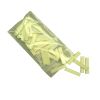YSI 6130 Rhodamine WT Sensor
Features
- Temperature compensation provides greater accuracy
- Turbidity and chlorophyll fluorescence rejection helps eliminate interferences
- Wiped optics field-proven for fouling prevention
- Expedited repair and warranty service
- Lifetime technical support
- More
Overview
The YSI 6130 sensor provides an accurate, in-situ measurements of Rhodamine WT in fresh, brackish, seawater, stormwater and wastewater. The 6130 is a fouling-resistant, wiped sensor designed to seamlessly integrate with all YSI sondes that contain an optical port without the need for external interface hardware.
Accuracy
The YSI 6130 Rhodamine WT Sensor rejects turbidity and chlorophyll interference. Measurement accuracy is further enhanced through correction for the effects of temperature.
Applications
The YSI 6130 sensor can be used in combination with those YSI sondes that have optical ports - 600 OMS, 6820, 6920, 6600, 6820 V2, 6920 V2, or 6600 V2 - and a YSI 650 MDS handheld display-logger. Make surface as well as vertical profile measurements. In addition, the YSI 6130 in combination with one of the YSI data logging sondes can be used for unattended continuous monitoring or integrated with data collection platforms for real-time data acquisition.
- Range: 0-200 ug/L
- Resolution: 0.1 ug/L
- Accuracy: +/-5% reading or 1 ug/L, whichever is greater
- Warranty: 2 years
In The News
Rhodamine Dye Tracer Systems
Until the advent of in situ rhodamine WT measurement systems, dye fluorometry hydrologic measurements were performed by the analysis of multiple samples physically extracted from the water body as the dye plume was naturally dispersed. Most of these investigations are performed using fluorometers designed for in vitro and pump-through measurements. Although these methods can produce accurate hydrologic data, they are resource-intensive, significantly vulnerable to human error and other natural phenomenon. They also necessitate the field deployment of personnel throughout the duration of the study. The recent employment of in situ measurement systems has accentuated the limitations of in vitro and pump-through methods for performing these studies.
Read MoreCal Poly, San Luis Obispo Manages Monitoring Efforts in Morro Bay
California Polytechnic State University, San Luis Obispo (Cal Poly, SLO), has been monitoring Morro Bay for decades, and while the monitoring program has changed over the years, the dedication to monitoring the bay has remained the same. The project started in 2006 as a Packard Foundation-funded initiative to monitor water quality flowing in and out of Morro Bay. The goal at the time was to use the data collected to develop and inform an ecosystem-based management plan in collaboration with the Morro Bay National Estuary Program (MBNEP). Since the estuary was the focus at the time, researchers were monitoring water flowing into the estuary from Chorro Creek and Los Osos Creek.
Read MoreGreen Water in Green Bay: Using Data Buoys to Monitor the Southern Bay
While the bay of Green Bay has been referred to as the largest freshwater “estuary” in the world, the watershed hosts intensive agriculture and contributes one-third of Lake Michigan’s total phosphorus load. The Fox River flows into the bay, carrying excess nutrients largely the result of non-point source runoff from the watershed. With a history of deterioration extending well into the last century, the bay ecosystem suffered significant declines in water quality. This, in turn, stimulated major clean-up and ongoing restoration efforts to improve water quality. Tracking these changes is an important aspect of ecosystem management.
Read More












